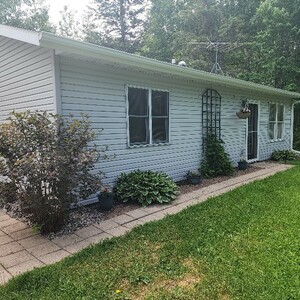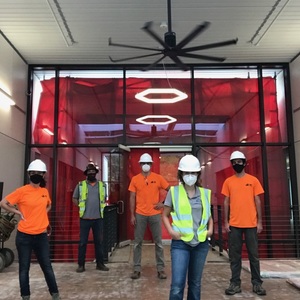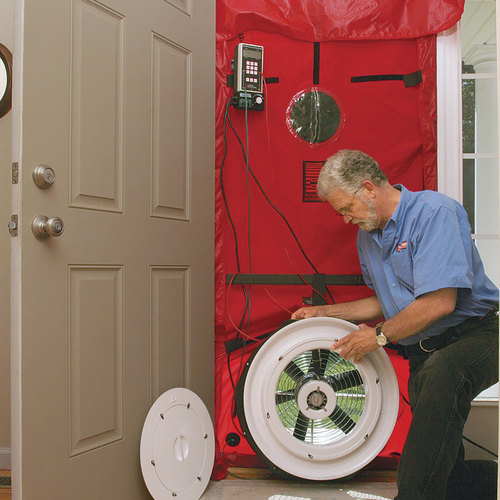
I recently conducted an initial blower-door test on a new home that I helped to design. We were at the rough-framing stage, and ended up with results that I had hoped for: .55ACH50 or 140cfm. Given the volume of the home, the leakage area was equal to approximately 15 sq. in. We were at a good point in the construction to do a little blower-door experimenting, so I borrowed Peter Yost’s wingnut hat and went to work.

I wanted to know how many holes of a specific size it would take to get this home to the code-required 3ACH50. I could have calculated the size of the hole mathematically but I had the opportunity to run an actual blower-door test and to make holes that would result in 3ACH50. I decided to drill several 2-1/2-in. holes in one of the yet-to-be-cut window openings.
A few things to bear in mind
A little more information on the home: There is more than 1500 sq. ft. of living area and a volume of around 14,800 cu. ft. To achieve 3ACH50, there has to be less than 740cfm of air flow moving past the blower-door fan (740cfm x 60 min. in an hour = 44,400 cfh / 3ACH50 = 14,800 cu. ft., or the volume of the home.) Given the first test result was 140cfm, I needed to add the equivalent of 600cfm of air leakage to get to the code requirement, so I drilled a hole in the OSB where a window would eventually be installed.
How many holes does it take?
The 2-1/2-in. hole, which has an area of 4.909 sq. in., increased the cfm of air moving across the fan to less than 180cfm—that’s an increase of less than 40cfm, so I drilled a second hole.

The photo above shows Tectite software from The Energy Conservatory, the manufacturer of the Minneapolis Blower Door. I use the software to control the blower door and to provide the test results. As you can see, the second hole brought the cfm rate to 235, which meant I needed to drill a bunch more holes to get to 740cfm. In the end, it took 15 holes to get to around 725cfm, or just under 3ACH50. Hole 16 would have pushed the home past 740cfm / 3ACH50.
Interpreting the wingnut results
The takeaway is that 3ACH50 or 90 sq. in. of leakage area for a 1500-plus-sq.-ft. home is considered “tight” (as least in the codes). The photo with 15 2-1/2-in. holes (plus the equivalent of three additional holes that accounted for the existing air leakage) is a great visual for demonstrating how all of the little holes in a building shell add up.
The ultimate goal for this home is 1ACH50 or less of total air leakage. The investment to get there is well under 1% of the total construction budget. What are we gaining? A savings of around 6% in energy costs. It may not seem like a lot of money but if you extend that savings over the life of the building, that’s nearly $10,000 savings. Of course, if the cost of energy increases, the savings will be even greater.
What this means for the homeowners
In terms of occupant comfort, the home will have fewer air leaks bringing in cold, dry winter air and warm, moist summertime air. I proved this over the past few weeks during the cool northern Minnesota fall, which has seen temperatures in the low teens a few times. The home is currently being heated by a single 1500-watt electric space heater. The Delta T—the difference between inside and outside temperatures—has been 30°F, sometimes 40°F. With just the one heater, indoor temperatures have been a consistent 60°F.
Less air leakage, especially during the winter months, will also limit the moisture moving through the building shell and making its way to a condensing surface. Less water in the building assemblies means reduced likelihood of moisture-related rot and mold, as well as better indoor air quality.
The heat recovery ventilator (HRV) being installed will be responsible for the filtered fresh air—not the air leakage around the window spray foam or across dust, building components, construction chemicals, or other nasties; in other words, the places where leaky homes often get their “fresh air.”
In my opinion, sealing air leaks is worth the investment for a structure that will hopefully be around for well over 100 years. Seeing how many holes are needed to achieve code-minimum was a real eye-opener.
_________________________________________________________________________
-Randy Williams is a builder and energy rater based in Grand Rapids, Minnesota. Photos courtesy of the author.
Weekly Newsletter
Get building science and energy efficiency advice, plus special offers, in your inbox.















6 Comments
> A savings of around 6% in energy costs
Also note that it has a more than 6% effect on equipment sizing (peak loads are influenced by stronger than average wind). So some reduced equipment cost too.
Also note that infiltration effects heating/cooling load balance. So less room-to-room variation when you air seal well. 6% on a 0F day - that windward side bedroom might be an unacceptable 4.2F too cold (vs only 1.4F with better air sealing). So some savings if you can avoid zoning equipment.
Good point Jon. This is the first new home for this customer, he's always lived in older homes. I'll be asking him later this winter if the home is comfortable, which was my main goal in the decision to improve the air sealing below the code minimum.
When I first started blower door testing (1980's) we would get an ACH50 reading and also an equivalent leakage area in square inches. This was much like you have done and does give another reference to air leakage. As I recall we were somewhere around 50 square inches for 2 story homes with basements around 3,500 total sf and an ACH50 of 1.25.
The size of the home matters and smaller homes have to be more airtight than larger homes to meet the same airtightness threshold. Not right that larger homes should get a pass. I have been in contact with builders recently in Maryland and Vermont that are just getting by on ACH50 requirements for their smaller homes but pass easily on the larger ones using the same air sealing protocol.
I agree with you Doug, I really like the CFM number over ACH50. I tested two homes this week, both were great tests, under .8 ACH50. One had a CFM of 400, the second was less than 150. One house was twice the volume of the other.
Randy,
Great to hear of houses testing below 1 ACH50. The comfort and energy savings will be there for the life of the home.
“[Deleted]”
Log in or create an account to post a comment.
Sign up Log in